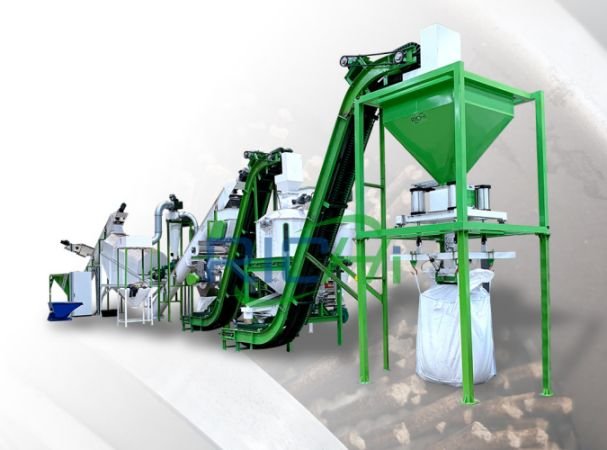Biomass rice husk pellet machines play a vital role in transforming rice husks into high-density pellets, which are used as renewable energy sources and animal feed. To ensure that these machines operate efficiently and have a long service life, it’s crucial to regularly inspect their components for potential issues. This guide covers the common problems associated with key components of a biomass rice husk pellet machine and offers practical maintenance tips to keep your machine running smoothly.
1. Pellet Die
Role: The pellet die shapes the raw rice husk material into pellets, making it one of the most essential parts of the machine.
Common Issues: Over time, the die may suffer from wear and tear, leading to problems such as enlarged holes, cracks, or uneven surfaces. These issues can degrade pellet quality, increase energy consumption, and lower production output.
Inspection Tips: After each production cycle, examine the die for visible signs of wear and damage. Measure the diameter of the holes to ensure they haven’t expanded beyond acceptable limits.
Maintenance Advice: Regularly clean the die to prevent clogging and remove any residue. Replace the die if significant wear is observed to maintain optimal machine performance.

2. Rollers
Role: Rollers compress the rice husk material against the die to form pellets.
Common Issues: Rollers can become worn or damaged, leading to uneven compression and slippage. This can result in inconsistent pellet quality and lower production rates.
Inspection Tips: Check the rollers weekly for signs of wear, such as cracks or uneven surfaces. Unusual noises during operation may also indicate roller issues.
Maintenance Advice: Ensure the rollers are properly aligned and adjusted to apply consistent pressure on the die. Replace them if they show significant wear or damage to avoid further problems.
3. Bearings
Role: Bearings support the rotating parts of the machine, such as the roller and die shafts.
Common Issues: Bearings may wear out due to excessive heat, contamination, or insufficient lubrication, leading to increased friction and potential failure.
Inspection Tips: Inspect bearings monthly for signs of wear, such as unusual noises, vibrations, or overheating. Look for grease leakage or contamination.
Maintenance Advice: Lubricate bearings regularly according to the manufacturer’s guidelines. Replace any bearings showing signs of excessive wear to prevent machine breakdowns.
4. Gearbox
Role: The gearbox transmits power from the motor to the pellet mill, ensuring the correct speed and torque are applied during the pelleting process.
Common Issues: Gearboxes can experience problems like oil leaks, unusual noises, or excessive vibrations, indicating potential damage to gears or bearings.
Inspection Tips: Inspect the gearbox monthly for wear or damage. Listen for unusual noises during operation and check for oil leaks.
Maintenance Advice: Change the gearbox lubricant as recommended by the manufacturer. Ensure proper alignment to prevent excessive wear.
5. Lubrication System
Role: The lubrication system provides essential lubrication to various moving parts of the pellet machine.
Common Issues: Inadequate lubrication can cause excessive wear, overheating, and damage to machine components.
Inspection Tips: Weekly, check the lubrication system for leaks, blockages, or low lubricant levels.
Maintenance Advice: Regularly refill lubricants as needed and use high-quality lubricants recommended by the manufacturer for optimal performance.
6. Feed Hopper
Role: The feed hopper is where rice husks are loaded into the machine for processing.
Common Issues: The hopper may develop blockages, cracks, or other damage that can disrupt material flow into the machine.
Inspection Tips: Daily, inspect the feed hopper for wear or damage. Ensure it’s clean and free from debris that could block material flow.
Maintenance Advice: Keep the hopper clean and well-maintained to ensure a consistent supply of raw materials. Promptly repair or replace any damaged components.
7. Cooling System
Role: The cooling system cools the pellets after they’re formed to maintain quality and prevent spoilage.
Common Issues: A malfunctioning cooling system can result in soft or deformed pellets, affecting their storage and transportation.
Inspection Tips: Weekly, check the cooling system for blockages, leaks, or inadequate cooling, indicated by soft or misshapen pellets.
Maintenance Advice: Ensure the cooling system works correctly and that air circulation is sufficient. Clean cooling components regularly to prevent performance issues. (Related post: rice husk pellet plant)
8. Electrical Components
Role: Electrical components, including the motor, control panel, and wiring, are critical for machine operation.
Common Issues: Electrical issues like frayed wires, loose connections, or overheating can lead to machine malfunctions.
Inspection Tips: Monthly, inspect electrical components for signs of wear or damage. Look for frayed wires, loose connections, or overheating.
Maintenance Advice: Ensure all electrical connections are secure and free from corrosion. Promptly replace any damaged wiring or components to avoid electrical failures.
9. General Maintenance Practices
Establish a Maintenance Schedule: Develop a regular maintenance schedule that includes inspections, lubrication, and part replacements based on the manufacturer’s recommendations.
Keep Records: Maintain detailed records of inspections, maintenance activities, and any issues encountered. This documentation can help identify patterns and guide future maintenance decisions.
Train Operators: Ensure that operators are trained in proper machine operation and maintenance procedures. They should be able to identify potential issues and perform basic maintenance tasks.
Conclusion
Regular inspection and maintenance of the key components of a biomass rice husk pellet machine are essential for ensuring optimal performance, consistent pellet quality, and minimizing downtime. By focusing on the pellet die, rollers, bearings, gearbox, lubrication system, feed hopper, cooling system, electrical components, and implementing general maintenance practices, you can extend the lifespan of your machine and improve its efficiency.
Investing in routine inspections and maintenance will pay off by reducing operational costs, improving product quality, and enhancing the reliability of your rice husk pellet production process. As the demand for renewable energy continues to grow, maintaining a well-functioning biomass pellet machine will be crucial for success in this competitive industry.










